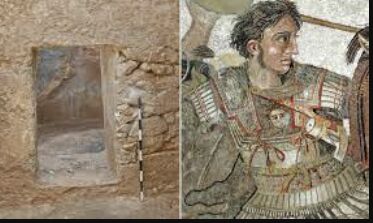Unearthing the Secrets of Alexander the Great: High-Class Greek Courtesan's Tomb Discovered in Jerusalem
Archaeologists in Jerusalem have unearthed the tomb of a Greek courtesan believed to have been involved with Alexander the Great, shedding light on ancient burial practices and the unique role of hetairai in society. This extraordinary discovery offers valuable insights into the life and times of one of history's most influential figures.
Archaeologists have made an intriguing discovery in Jerusalem, Israel, unearthing the tomb of a high-class Greek courtesan, or hetaira, who is believed to have had relations with the infamous military commander, Alexander the Great. This extraordinary find offers a unique glimpse into the life and times of one of history's greatest conquerors and is a groundbreaking revelation for archaeologists. The tomb was found in a cave on the road to Jerusalem, dating back approximately 2,300 years. It was located far from any settlement and contained the remains of a young woman, along with an exceptionally well-preserved box mirror.
Archaeologists May Have Found First-ever Grave of Hetaira From Time of Alexander the Great
— Sarah (@Sarah404BC) September 28, 2023
Tomb on road to Jerusalem, grave goods of nails & box mirror from the time of Alexander of Macedonia, archaeologists surmise this woman was a Greek courtesanhttps://t.co/EcFpTRu9q8 pic.twitter.com/eeEYsraAsZ
The analysis of the grave and its contents led experts to conclude that this was the resting place of a Greek hetaira, marking one of the first such tombs to be discovered in the ancient Greek world. The burial site, intricately carved into limestone bedrock, featured an entrance room and an interior burial chamber, both plastered. The woman's remains were found disarticulated and showed signs of cremation, making it the earliest known instance of cremation from the Hellenistic period in Israel. The inclusion of luxury items like iron nails and an ornate bronze mirror indicated the high status of the deceased, suggesting she was a hetaira who provided professional escort services.
This discovery not only sheds light on the sociocultural dynamics of the Hellenistic period but also offers insights into the lives of hetairai, who were more than just sexual companions. They were educated and cultured women who could entertain through various artistic forms. Moreover, the tomb's location and its distance from settlements challenge preconceived notions about the roles of Greek wives, further emphasizing the unique position of hetairai in society. The find also provides invaluable information about funeral practices during this time, particularly the previously unknown use of cremation in the region.
The inclusion of personal belongings, such as the rare box mirror, highlights the importance of material possessions in ancient burial customs. Further research and analysis of the mirror may reveal more about the woman's background, her relationship with the person who gifted her the mirror, and potentially even the identity of this person. Additionally, this discovery paves the way for future exploration and excavation, offering the possibility of uncovering more hetaira tombs and expanding our understanding of the cultural intricacies of the Hellenistic period. Overall, the tomb of the Greek courtesan provides a fascinating window into a forgotten and vanished ancient world and highlights the significance of combining archaeology and research to unravel historical narratives.




